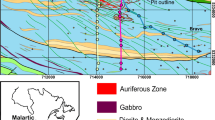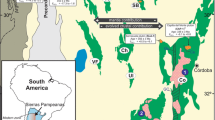Abstract
Previous stable isotope studies at Lizzies Basin revealed that metasedimentary rocks are 18O-depleted relative to protolith values, particularly in the lower parts of the section (Lower Zone) where the rocks are also isotopically homogeneous on a scale of hundreds of meters (quartz δ18O=+9.0 to +9.6 per mil). In contrast, metasedimentary rocks at higher levels at Lizzies Basin (Upper Zone) are less 18O-depleted and more heterogeneous in δ18O. In order to understand more fully the isotopic evolution of this terrane, a series of detailed, meter-scale traverses across various metamorphic and igneous lithologies were completed at Lizzies Basin, and at the structurally higher Angel Lake locality. Traverses in the Lizzies Basin Lower Zone and in the lower parts of Angel Lake (Angel Lake Lower Sequence) across various silicate lithologies, including abundant granitoids, reveal similar degrees of homogeneity, although the average δ18O values are higher at Angel Lake. In contrast, traverses which include substantial thicknesses of marble and calc-silicate gneiss and very little granitoid have more heterogeneous quartz δ18O values (+11.9 to +13.4 per mil), and also have a higher average δ18O (+12.9 per mil), than observed elsewhere. The scale of 18O/16O homogeneity in quartz observed at Lizzies Basin and Angel Lake (meters to hundreds of meters) requires fluid-mediated isotope exchange, which accompanied Tertiary metamorphism. There is a correlation between the degree of 18O-depletion in metasedimentary rocks, 18O/16O homogenization between lithologies, and the proportion of granitoids (leucogranites in particular) within any part of the section, and a corresponding anticor-relation with the proportion of marble. This points to a causal relationship, whereby the leucogranites (as well as the Tertiary hornblende diorite and biotite monzogranite) acted as both a relatively low-18O reservoir and a source of fluids to enhance exchange, while the marbles hindered isotope deplction and homogenization by acting as relatively high-18O reservoirs and impermeable layers. Material balance calculations help delineate the plausible mechanisms of exchange between granitoids and metasediments. Single-pass infiltration of magmatic fluids from the granitoids is not capable of reproducing all of the observations. Fluidmediated exchange by convective recirculation of magmatic fluids on a scale of meters is the mechanism which explains all of the observations. The generalized model for the isotopic evolution of the East Humboldt Range core complex provides and excellent opportunity to establish the main causes and controlling factors of 18O-depletion and 18O/16O homogenization during regional metamorphism.
Similar content being viewed by others
References
Armstrong RL, Ward P (1991) Evolving geographic patterns of Cenozoic magmatism in the North American Cordillcra: the temporal and spatial association of magmatism and metamorphic core complexes. J Geophys Res 96:13201–13224
Baker AJ (1988) Stable isotope evidence for limited fluid infiltration of deep crustal rocks from the Ivrea Zone, Italy. Geology 16:492–495
Baker AJ (1990) Stable isotopic evidence for fluid-rock interaction in the Ivrca Zone, Italy. J Petrol 31:243–260
Baker J, Bickle MJ, Buick IS, Holland TJB, Matthews A (1989) Isotopic and petrologic evidence for the infiltration of water-rich fluids during the Miocene M2 metamorphism on Naxos, Greece. Geochim Cosmochim Acta 53:2037–2050
Bebout GE, Carlson WD (1986) Fluid evolution and transport during metamorphism: evidence from the Llano Uplift, Texas. Contrib Mineral Petrol 92:518–529
Bickle MJ (1992) Transport mechanisms by fluid flow in metamorphic rocks: oxygen and strontium decoupling in the Trois Seigneurs Massif — a consequence of kinetic dispersion? Am J Sci 292:289–316
Bickle MJ, McKenzie D (1987) The transport of heat and matter by fluids during metamorphism. Contrib Mineral Petrol 95:384–392
Blattner P, Lassey KR (1989) Stable-isotope exchange fronts, Damkohler numbers, and fluid to rock ratios. Chem Geol 78:381–392
Cartwright I, Valley JW (1991) Steep oxygen-isotope gradients at marble-metagranite contacts in the northwest Adirondacks Mountains, New York, USA: products of fluid-hosted diffusion. Earth Planet Sci Lett 107:148–163
Chamberlain CP, Rumble D (1988) Thermal anomalies in a regional metamorphic terrane: an isotopic study of the role of fluids. J Petrol 29:1215–1232
Criss RE, Fleck RJ (1987) Petrogenesis, geochronology, and hydrothermal systems of the northern Idaho batholith, adjacent areas based on 18O/16O, D/H, 87Sr/86Sr, K-Ar, and 40Ar/39Ar studies. US Geol Surv Pap 1436:95–137
Crittenden MDJr, Coney PJ, Davis GH (1980) Cordilleran metamorphic core complexes. Geol Soc Am Mem 153
England PC, Thompson AB (1984) Prssure-temperature-time paths of regional metamorphism I. Heat transfer during the evolution of regions of thickened continental crust. J Petrol 25:894–928
Eslinger EV, Savin SM (1973) Oxygen isotope geothermometry of the burial metamorphic rocks of the Precambrian Belt Supergroup, Glacier National Park, Montana. Bull Geol Soc Am 84:2549–2560
Ferry JM (1988) Infiltration-driven metamorphism in northern New England, USA. J Petrol 29:1121–1159
Ferry JM (1992) Regional metamorphism of the Waits River Formation, eastern Vermont: delineation of a new type of giant metamorphic hydrothermal system. J Petrol 33:45–94
France-Lanord C, LeFort P (1988) Crustal melting and granite genesis during the Himalayan orogenesis. Trans R Soc Edinburgh Earth Sci 79:183–195
Friedman I, O'Neil JR (1977) Compilation of stable isotope fractionation factors of geochemical interest. US Geol Surv Prof Pap 440-KK
Ganor J, Matthews A, Paldov N (1989) Constraints on effective diffusivity during oxygen isotope exchange at a marble-schist contact, Sifnos (Cyclades), Greece. Earth Planet Sci Lett 94:208–216
Garlick GD, Epstein S (1967) Oxygen isotope ratios in coexisting minerals of regionally metamorphosed rocks. Geochim Cosmochim Acta 31:181–214
Giletti BJ (1986) Diffusion effects on oxygen isotope temperatures of slowly cooled igneous and metamorphic rocks. Earth Planet Sci Lett 77:218–228
Grunder AL, Wickham SM (1991) Homogenization and lowering of 18O/16O in mid-crustal rocks during extension-related magmatism in eastern Nevada. Earth Planet Sci Lett 107:416–431
Hodges KV, Snoke AW, Hurlow HA (1992) Thermal evolution of a portion of the Sevier Hinterland: the northern Ruby Mountains-East Humboldt Range and Wood Hills, northeastern Nevada. Tectonics 11:154–164
Howard KA, Kistler RW, Snoke AW, Willden R (1979) Geologic map of the Ruby Mountains, Nevada. US Geol Surv Misc Invest Ser Map I-1136, scale 1:125,000
Kistler RW, Ghent ED, O'Neil JR (1981) Petrogenesis of garnet two-mica granites in the Ruby Mountains, Nevada. J Geophys Res 86:10591–10606
Koons PO, Craw D (1991) Gold mineralization as a consequence of continental collision: an example from the southern Alps, New Zealand. Earth Planet Sci Lett 103:1–9
Longstaffe FJ, Lerny P, Muehlenbachs K (1981) Oxygen-isotope geochemistry of the granitoid rocks in the Winnipeg River pegmatite district, southeastern Manitoba. Can Mineral 19:195–204
Lush AP, McGrew AJ, Snoke AW, Wright JE (1988) Allochthonous Archean basement in the northern East Humboldt Range, Nevada. Geology 16:349–353
McCrea JM (1950) On the isotopic chemistry of carbonate and a paleotemperature scale. J Chem Phys 18:849–857
McGrew AJ (1992) Tectonic evolution of the northern East Humboldt Range, Elko County, Nevada (unpublished) PhD thesis, University of Wyoming, Laramie
Nabelek PI, Labotka TC, O'Neil JR, Papike JJ (1984) Contrasting fluid-rock interaction between the Notch Peak granitic intrusion and argillites and limestones in Western Utah: evidence from stable isotopes and phase assemblages. Contrib Mineral Petrol 86:25–34
Norton D, Taylor HPJr (1979) Quantitative simulation of the hydrothermal systems of crystallizing magmas on the basis of transport theory and oxygen isotope data: an analysis of the Skaergaard intrusion. J Petrol 20:421–486
Patino Douce AE, Humphreys ED, Johnston AD (1990) Anatexis and metamorphism in tectonically thickened continental crust exemplified by the Sevier hinterland, western North America. Earth Planet Sci Lett 97:290–315
Peters MT (1992) A petrologic and stable isotope study of the role of fluids in high-grade metamorphism: the East Humboldt Range, Nevada, USA (unpublished). PhD thesis, University of Chicago
Peters MT, McGrew AJ (1994) Timing of extension and metamorphism in the East Humboldt Range core complex, Nevada. Geol Soc Am Abstr Program 26:81
Peters MT, Wickham SM (1994) Petrology of upper amphibolite facies marbles from the East Humboldt Range, Nevada, USA; evidence for high-temperature, retrograde, hydrous volatiles fluxes at mid-crustal levels. J Petrol 35:205–238
Peters MT, Wickham SM, Miller DM (1992) High δ13C Late Proterozoic carbonates of the North American Cordillera. Geol Soc Am Abstr Program 24:114
Podladchikov YY, Wickham SM (1994) Crystallization of hydrous magmas: calculation of associated thermal effects, volatile fluxes, and isotopic alteration. J Geol 102:25–45
Powers RE, Bohlen SR (1985) The role of synmetamorphic igneous rocks in the metamorphism and partial melting of metasediments, northwest Adirondacks. Contrib Mineral Petrol 90:401–409
Sandiford M, Powell R (1986) Deep crustal metamorphism during continental extension: modern and ancient examples. Earth Planet Sci Lett 79:151–158
Sharma T, Clayton RN (1965) Measurement of 18O/16O ratios of total oxygen from carbonates. Geochim Cosmochim Acta 29:1347–1353
Shieh Y, Schwarcz HP (1974) Oxygen isotope studies of granite and migmatite, Grenville Province of Ontario. Geochim Cosmochim Acta 38:21–45
Snoke AW, Lush AP (1984) Polyphase Mesozoic-Cenozoic deformational history of the northern Ruby Mountains-East Humboldt Range, Nevada. In: Lintz JJr (ed) Western geological excursions. Geol Soc Am 1984 Annu Meet, Reno, Nevada, 4:232–260
Snoke AW, Miller DM (1988) Metamorphic and tectonic history of the northeastern Great Basin. In: Ernst WG (ed) Metamorphism and crustal evolution, western coterminus United States. Rubey Volume VII, Prentice Hall, Englewood Cliffs, New Jersey, pp 606–649
Snoke AW, McGrew AJ, Valasek PA, Smithson SB (1990) A crustal cross-section for a terrain of superimposed shortening and extension: Ruby Mountains-East Humboldt Range metamorphic core complex, Nevada. In: Salisbury MH, Fountain DM (eds) Exposed cross-sections of the continental crust. Kluwer Academic Publishers, Dordrecht, Netherlands, pp 103–135
Taylor BE, Foord EE, Friedrichsen H (1979) Stable isotope and fluid inclusion studies of GEM-bearing granitic pegmatite-aplite dikes, San Diego Co., California. Contrib Mineral Petrol 68:187–205
Taylor HPJr (1977) Water/rock interactions and the origin of water in granitic batholiths. J Geol Soc London 133:509–558
Taylor HPJr, Epstein S (1962) Relationships between 18O/16O ratios in coexisting minerals of igneous and metamorphic rocks. I. Principles and experimental results. Bull Geol Soc Am 73:461–480
Valley JW, Bohlen SR, Essene EJ, Lamb W (1990) Metamorphism in the Adirondacks. II. The role of fluids. J Petrol 31:555–596
Wells PRA (1980) Thermal models for magmatic accretion and subsequent metamorphism of continental crust. Earth Planet Sci Lett 46:253–265
Wickham SM, Oxburgh ER (1985) Continental rifts as a setting for regional metamorphism Nature 318:330–333
Wickham SM, Peters MT (1990) An oxygen isotope discontinuity in high-grade rocks of the East Humboldt Range, Nevada. Nature 345:150–153
Wickham SM, Peters MT (1992) Oxygen and carbon isotope profiles in metasediments from Lizzies Basin, East Humboldt Range, Nevada: constraints on mid-crustal metamorphic and magmatic volatile fluxes. Contrib Mineral Petrol 112:46–65
Wickham SM, Peters MT (1993) High δ13C Neoproterozoic carbonate rocks in western North America. Geology 21: 165–168
Wickham SM, Taylor HPJr (1985) Stable isotopic evidence for large-scale seawater infiltration in a regional metamorphic terrane; The Trois Seigneurs Massif, Pyrenees, France. Contrib Mineral Petrol 91:122–137
Wickham SM, Taylor HPJr, Snoke AW, O'Neil JR (1991) An oxygen and hydrogen isotope study of high-grade metamorphism and anatexis in the Ruby Mountains-East Humboldt Range core complex, Nevada. In: Taylor HPJr, O'Neil JR, Kaplan IR (eds) Stable isotope geochemistry: a tribute to Samuel Epstein. Geochim Soc Spec Publ 3:373–390
Wickham SM, Peters MT, Fricke HC, O'Neil JR (1993) Core complex plumbing systems: identification of magmatic and meteoric fluid sources and upward and downward moving infiltration fronts. Geology 21:81–84
Wright JE, Snoke AW (1993) Tertiary magmatism and mylonitization in the Ruby-East Humboldt Metamorphic core complex, northeastern Nevada: U-Pb geochronology and Sr, Nd, and Pb isotope geochemistry. Bull Geol Soc Am 105:935–952
Author information
Authors and Affiliations
Rights and permissions
About this article
Cite this article
Peters, M.T., Wickham, S.M. On the causes of 18O-depletion and 18O/16O homogenization during regional metamorphism; the East Humboldt Range core complex, Nevada. Contr. Mineral. and Petrol. 119, 68–82 (1995). https://doi.org/10.1007/BF00310718
Received:
Accepted:
Issue Date:
DOI: https://doi.org/10.1007/BF00310718




